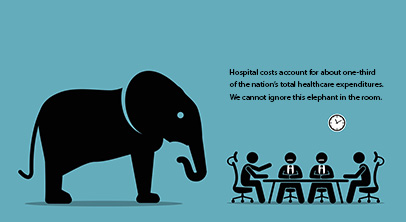No matter what overall system you favor, e.g. private insurance, the Affordable Care Act (ACA), or Medicare for All – any system is bound for implosion under the burden of ever increasing costs. Hospital costs account for about one-third of the nation’s total expenditures on health care – making it the largest category of health spending. The latest figures show this amounted to $1.2 trillion in 2018. Prescription drug expenditures, by way of comparison, amounted to $335 billion in the same year, consuming less than 10 percent of the health care expenditures pie.
The Rand study researched the impact of three different strategies to reduce hospital prices paid by private health plans:
- hospital rate setting whereby all or selected groups pay the same rates for hospital services;
- price transparency for hospital services (e.g. posting prices charged for common hospital procedures, allowing consumers or payers to shop for price);
- increasing competition among hospitals and/or breaking up the health care behemoths that can raise prices because there is no competition in a given area.
What is hospital rate setting?
A process that regulates payment rates for hospital services. Many types of groups pay for hospital services: employers; private insurers; individual markets; Medicare and Medicaid are the major ones. Under rate setting, one or more of these groups (called payers) pay for hospital services at the rates established in the rate setting process.
Rate setting offers biggest savings
The biggest impact on hospital spending for private plans occurs through regulation of payment rates, according to the study’s key findings. Setting rates at 100 or 150 percent of Medicare rates could reduce employer and insurer costs for hospital spending anywhere from $61.9 billion to $236.6 billion annually – effecting a 1.7 to 6.5 percent reduction in national health spending.
Rand Corporation Study:
Estimated impacts of strategies to curb hospital prices for private health plans*
|
Policy action |
Estimated annual reduction in hospital spending paid by private health plans* |
|
Rate Setting |
$61.9 billion to $236.6 billion |
|
Price Transparency |
$8.7 billion to $26.6 billion |
| Increased competition |
$6.2 billion to $68.9 billion |
*private health plans include employer-sponsored insurance plans and all non-governmental commercial health plans.
Savings estimates achieved through increasing competition or price transparency pale in comparison to the rate setting model.
Increased competition could save in the range of $6.2 billion to $68.9 billion annually, though the study suggests it may not be a realistic option. This is because many hospital markets are already so highly consolidated, that the degree of restructuring necessary to create truly competitive markets would be difficult to achieve.
A price transparency model saves anywhere from $8.7 billion to $26.6 billion per year. The higher range of savings would come from an employer-driven scenario whereby price information is used to steer patients toward lower-cost options. Patients are not always willing to use the lowest cost option, rightfully choosing to focus on optimal health outcomes.
But the problems with rate setting are . . .
The Rand study authors also identify potential problems with rate setting such as hospital closures; quality of care issues; and immense political opposition. The study doesn’t do a deep dive into these potential problems, but there are real world examples of hospital price setting already enacted by states. One example in particular provides some guidance on how obstacles can be handled.
Maryland’s real world experience
Of all the programs enacted, the Maryland hospital all-payer system has been in effect the longest (since 1977) and has even earned high marks from the Maryland Hospital Association. The Maryland system operates through an independent state agency called the Health Services Cost Review Commission (HSCRC). The agency sets hospital rates that apply to all health care payers including private insurers, employers, individual market and Medicare/Medicaid. The HSCRC’s broader responsibilities include quality assurance, access, and public disclosure of hospital data including operating performance.
In its latest evaluation of the Maryland all-payer system, the Center for Medicare and Medicaid Innovation (CMMI) finds that reduced total hospital expenditures have resulted, as well as hospital investments in better care strategies. A CMMI leader who worked on the Maryland evaluation expressed on social media, “what I’m most impressed with is the decrease in potentially avoidable hospitalizations.”
According to research from the health care research firm Altarum, the Maryland system has endured through diligent adherence to:
Stakeholder support. Strong representation of both consumer and provider voices is key. While the Maryland Hospital Association first supported the system as a way to address uncompensated care costs, they’ve stayed on board because their overall cost concerns are heard and addressed. A global budget system provides fixed, predictable revenues tied to performance measures such as improving patient experience, patient safety indicators and complications, and mortality. Consumer advocates see that patient quality metrics have improved, particularly for high-cost, high-need patients.
Flexibility. The all-payer system evolved over the years to address the inevitable problems that surfaced with implementation. By statute, the all-payer system identifies key goals, but not compulsory methods for achieving those goals. Since 1977, the all-payer system has gone through four major updates to address problems such as getting hospital admission rates under control, containing overall hospital costs, and even expanding into working with community health providers to participate in their Total Cost of Care (TCOC) model.
Political and budgetary independence. The HSCRC is a state agency, though funded through assessments on hospitals. The governor appoints the agency’s seven volunteer commissioners with representation from provider and consumer organizations. In addition to establishing hospital price rates, the agency is charged with creating efficiencies, access for all, equity among payers, and solvency for effective hospital operation.
Of the potential problems identified in the Rand study, the Maryland all-payer system demonstrated that: a.) bringing all health care stakeholders together went a long way in diffusing organized political opposition; b.) measurable quality care is part of the system; and c.) hospitals are being paid enough to stay open. No hospitals have closed in Maryland. States with comparable numbers of hospitals such as Minnesota and Kansas have experienced some rural hospital closures. Hospital closures, however, encompass a complex number of factors that make comparisons difficult. Maryland is a small state with a relatively small rural population, which is where the highest number of hospital closures occur.
Key elements in program design
The Rand study identifies no less than 19 programs or proposals for rate setting or capping rates at state and federal levels. This level of activity indicates massive volumes of study and analysis have already been undertaken on this topic. Three key elements in a program’s design will affect the savings potential, according to the Rand study authors:
Basis upon which rates are established. Rates can be based upon Medicare rates, historical hospital revenues, commercial rates, or some combination thereof. Careful analysis is required to strike a balance between achieving savings and fair, equitable payment schedules to keep hospitals afloat and providing high quality care.
The scope of rate setting. Many types of payers make payments for health care services: employers; private insurers; individual markets; Medicare and Medicaid are the major ones. If rate setting only applies to one type of payer, e.g. a benefit plan for state employees (as is the case in North Carolina and Montana), savings will have less impact than a system such as Maryland’s all-payer system which includes every type of payer. Other states have chosen to limit their scope to specific groups: Washington state sets rates only for public option plans; Oregon rates effect public and education employee boards.
Whether rates will be set or capped. Capping rates can be more politically palatable because it targets egregiously high prices while leaving reasonable or even low prices unaffected. If prices below the cap do indeed remain unchanged, significant savings can be realized. If those prices rise to the cap, increased spending could result.
Further, overall savings from set or capped rates would fluctuate based on the number of hospitals affected, for example, a set rate or cap at 200 percent of the Medicare rate would likely affect fewer hospitals than a set rate or cap at 100 percent of the Medicare rate.
Insurers off the hook?
The American Hospital Association strongly criticized the Rand study, citing revenue losses hospitals are already burdened with such as uncompensated care, rising costs and other market pressures. The Association says hospitals are being squeezed between low Medicare/Medicaid payment rates and commercial health insurers who are experiencing record profits while spending less on actual care. Price setting, from their perspective, would exacerbate these pressures.

Political will to do it right
Perhaps the American Hospital Association criticisms reflect more upon the problems that the Rand study actually addresses, i.e. rising costs are making our health care system unsustainable, and we need to do something about this. Finding the political will to strike the correct balance of payments to assure hospitals can stay afloat while providing quality care is not easy. It requires every player to come to the table with a focus on the health care system, rather than anyone’s bottom line.



